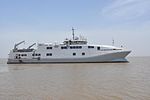Dehradun () is the capital and the most populous city of the Indian state of Uttarakhand. It is also known as the school capital of India. It is the administrative headquarters of the eponymous district and is governed by the Dehradun Municipal Corporation, with the Uttarakhand Legislative Assembly holding its winter sessions in the city as its winter capital. Part of the Garhwal region, and housing the headquarters of its Divisional Commissioner. Dehradun is one of the "Counter Magnets" of the National Capital Region (NCR) being developed as an alternative center of growth to help ease the migration and population explosion in the Delhi metropolitan area and to establish a smart city in the Himalayas. It is the third largest city in the Himalayas after Kathmandu and Srinagar.
Dehradun is located in the Doon Valley on the foothills of the Himalayas nestled between Song river, a tributary of Ganga on the east and the Asan river, a tributary of Yamuna on the west. The city is noted for its picturesque landscape and slightly milder climate and provides a gateway to the surrounding region.
Dehradun is a notable academic and research hub and is home to the Indian Military Academy, Forest Research Institute, Indira Gandhi National Forest Academy, The Doon School, Welham Boys School, Welham Girls School, Brightlands School, Rashtriya Indian Military College, Uttarakhand Ayurveda University, Wadia Institute of Himalayan Geology and the Indian Institute of Remote Sensing. It is the headquarters of the Surveyor-General of India. According to the combined survey based on health, infrastructure, economy, education, and crime, conducted by Dainik Jagran and KPMG, Dehradun is one of India's safest cities. Dehradun is also known for its Basmati rice and bakery products.
Also known as the 'Abode of Drona', Dehradun has been an important center for Garhwal rulers and was captured by the British. For its strategic value, in addition to the location of its principal service academy, the Indian Armed Forces maintain a considerable presence in Dehradun, at the Garhi Cantonment and Naval Station. The Uttarakhand Police is the primary law enforcement agency in the city.It is well connected and in proximity to Himalayan tourist destinations such as Mussoorie, Dhanaulti, Chakrata, New Tehri, Uttarkashi, Harsil, Chopta-Tungnath, Auli, and famous summer and winter hiking destinations like the Valley of Flowers at Dodital, Dayara Bugyal, Kedarkantha, Har Ki Dun and Hemkunt Sahib for camping and Himalayan panoramic views. The Hindu holy cities of Haridwar and Rishikesh, along with the Himalayan pilgrimage circuit of Chota Char Dham, viz. Yamunotri, Gangotri, Kedarnath and Badrinath, are also primarily accessed via Dehradun, the closest major city.




